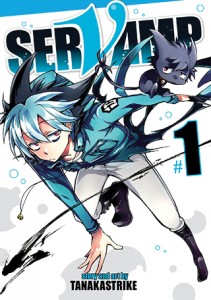By Strike Tanaka. Released in Japan by Media Factory, serialization ongoing in the magazine Comic Gene. Released in North America by Seven Seas.
In general, I’m very reluctant to talk about a manga or anime being unoriginal, mostly as many of my absolute favorite titles have been made of of little bundles of cliches. Particularly shoujo titles, and Comic Gene is sort of a shoujo-ish magazine, if you squint. That said, after reading the first volume of Servamp, my general reaction was “that was pretty good, but I feel I’ve read it all before”. It might just be that I am simply vampire’d out – the North American market is absolutely glutted with vampire manga, with more and more coming every month, and Servamp (Vampire Servant, in case you were unaware) is another example of the genre. That said, it’s not actually a bad volume, just a little worn.
Our hero Mahiru is a serious young man who tends to get irritated easily (though that gets toned down later in the book when he meets another young man who also gets irritated easily), but is more defined by his inability to stand aside when there are people that need help. He even picks up stray cats on the street, which proves to be his undoing when said cat turns out to actually be the immortal vampire Kuro. Not that Kuro is all that impressive – he’s lazy as hell, not wanting to show off his strength even when it would save lives. Turns out he is one of seven (at least we’re told seven at the start) vampires based on the Seven Deadly Sins, and Kuro happens to be Sloth. But Mahiru won’t let him slack, especially when someone appears to be going on a vampire killing spree in the city.
This description likely makes the title sound more serious than it is. There’s lots of light-heartedness iin this series, particularly in the interaction between Mahiru and Kuro. As you can see from the cover art, Kuro has this sort of sleepy hangdog look that’s funny even when he’s at rest, and his desire for food/drink/sleep just gets even funnier because of it. Later in the series we meet more eccentric vampires, including Love (asks Mahiru to check out his “boobies”, despite being male) and Wrath (the sole female character, who has a pissed-off expression on her face in order to “look cool”). And the one major death we actually see is semi-handwaved away the following day, for reasons as yet unknown.
So it’s put together well, but again, there’s a sense you’ve seen this all before. The use of the Seven Deadly Sins as eccentric weirdos is unfortunate coming after Kodansha’s license of a shonen series with a similar premise. Mahiru’s grumpy straight-man lead reminds me a bit of Devils and Realist, and honestly there’s also a bit of Alice here as well, in terms of his gradually acquiring a bunch of seeming killers around him. (The author has apparently done BL in the past, but there’s no real teasing here, though Love seems very camp.) Even the cliffhanger ending made me say “yeah, I was expecting that surprise.” It’s well told, and fans of manga with lots of handsome young men or supernatural action series might enjoy it. But I hope to be at least startled by a plot or character in the future.


Speak Your Mind